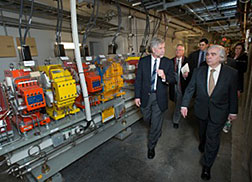- Number 433 |
- February 23, 2015
Brookhaven dedicates 'brightest beacon at the frontiers of discovery'

U.S. Department of Energy Secretary
Ernest Moniz (right) touring NSLS-II with Project
Director Steve Dierker and
Lab Director Doon Gibbs.
From the floor to the rafters, the world's most advanced synchrotron light source was filled with hundreds of people—including U.S. Department of Energy (DOE) Secretary Ernest Moniz, U.S. Senator Chuck Schumer, U.S. Representatives Lee Zeldin and Kathleen Rice, and a number of other distinguished guests—who gathered as Secretary Moniz dedicated the National Synchrotron Light Source II (NSLS-II) at Brookhaven Lab on Feb. 6.
NSLS-II is a $912-million DOE Office of Science User Facility that produces extremely bright beams of x-ray, ultraviolet, and infrared light. With x-rays 10,000 times brighter than its predecessor's, researchers at NSLS-II will examine a wide range of materials, including superconductors and catalysts, geological samples, and biological proteins to accelerate advances in energy, environmental science, and medicine.
"Now that it's completed, NSLS-II will pick up where NSLS left off," said Lab Director Doon Gibbs, who emceed the dedication and welcomed a number of special guests, including Deputy Under Secretary for Science and Energy and a former chair of NSLS Michael Knotek.
Gibbs also noted the support of DOE's Deputy Director for Science Programs for the Office of Science Pat Dehmer and Associate Director of Science for Basic Energy Sciences Harriet Kung in shepherding the NSLS-II project. He then thanked New York State Governor Andrew Cuomo and the state for a recently announced $65 million commitment to Brookhaven Lab.
Unprecedented Capabilities for Research at NSLS-II
Esther Takeuchi—a battery researcher who holds a joint appointment with Brookhaven Lab and Stony Brook University—said, "Now we've moved into the realm of true in operando, where with a light source like NSLS-II, we can gain unprecedented resolution faster than ever to see what's happening in an actual working battery without modifying it. I believe that this really is going to lead to unprecedented insight, unprecedented ability to solve the challenges that can contribute to addressing the energy needs of the world."
Secretary Moniz then took to the stage and said, "These types of user facilities are just so essential for the entire American research enterprise, and so Brookhaven and our other national laboratories will continue to be a foundation for American science.
"NSLS-II, an extremely fitting successor to NSLS: We expect no less from you over the next couple of decades, in science and in the whole influence of our scientific enterprise," Moniz added, before recognizing the project management that led to the facility being completed on budget—with increased scope—and significantly under schedule.
After the ceremony, Moniz visited NSLS-II, the STAR detector at the Relativistic Heavy Ion Collider, and the Center for Functional Nanomaterials, and met briefly with Lab researchers during a whirlwind tour.[Joe Gettler, 631.344.3584,
jgettler@bnl.gov]
